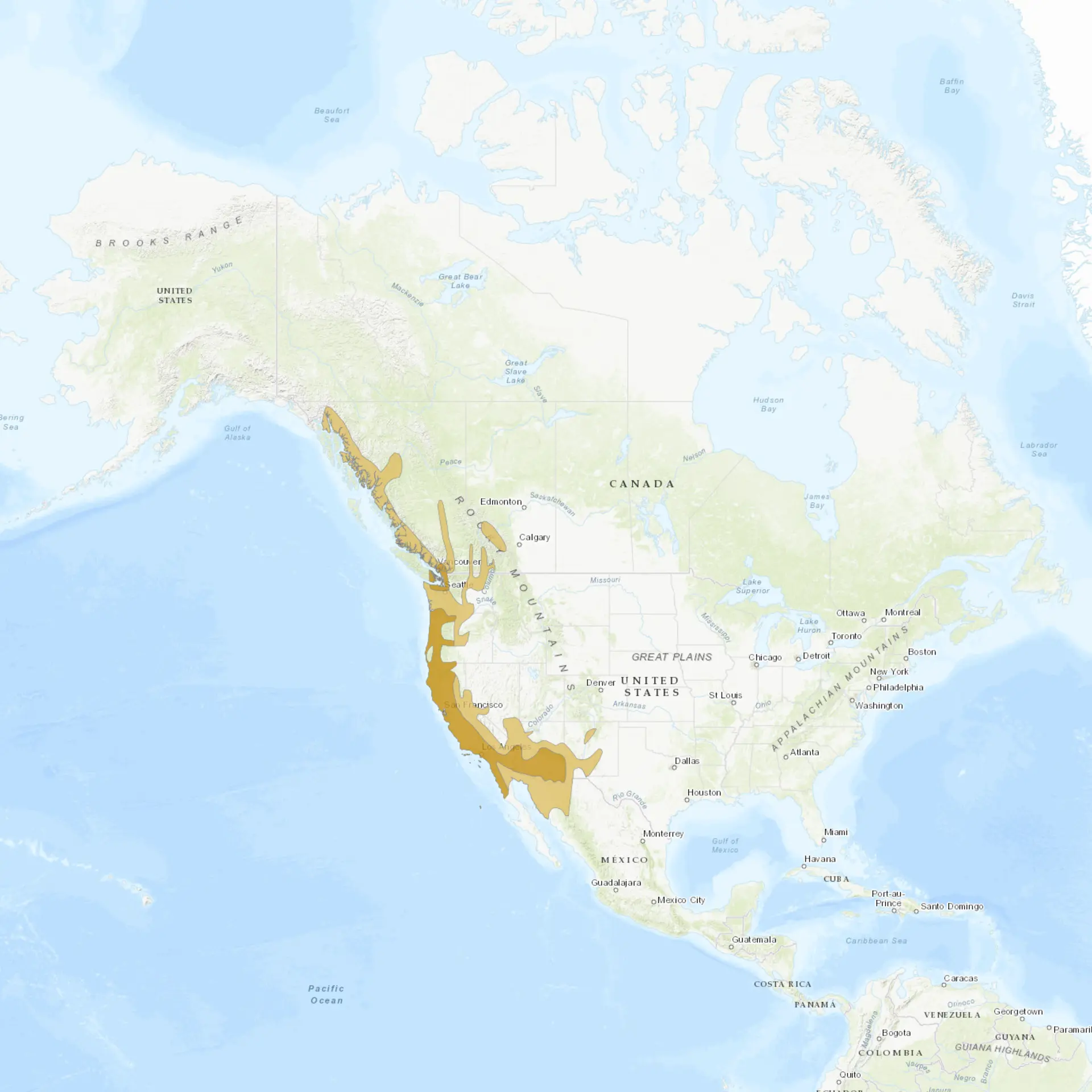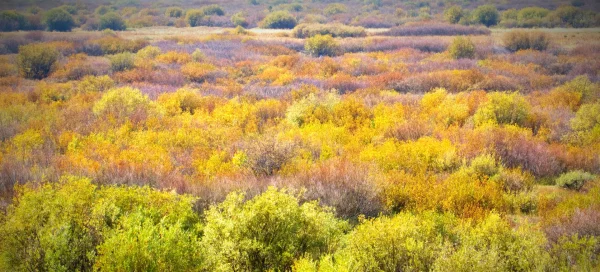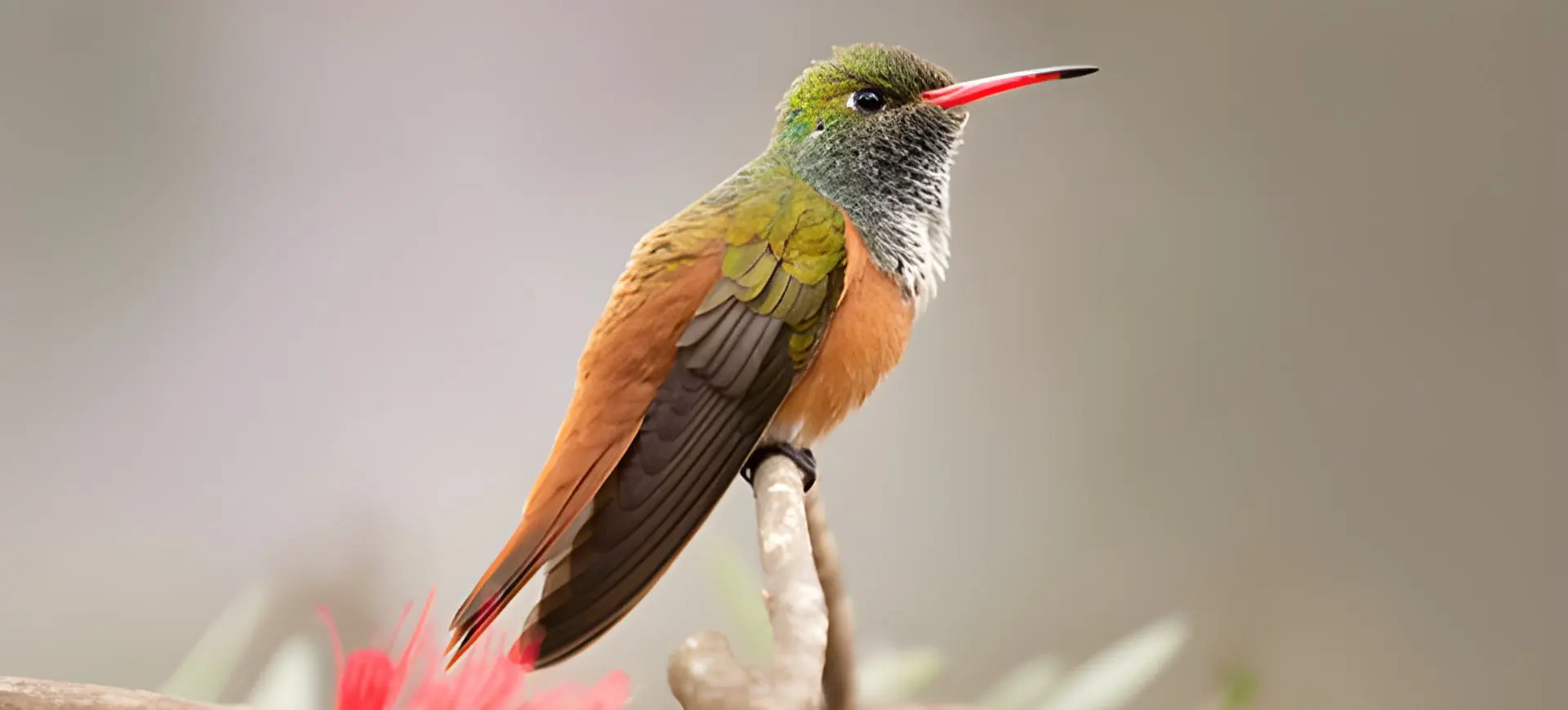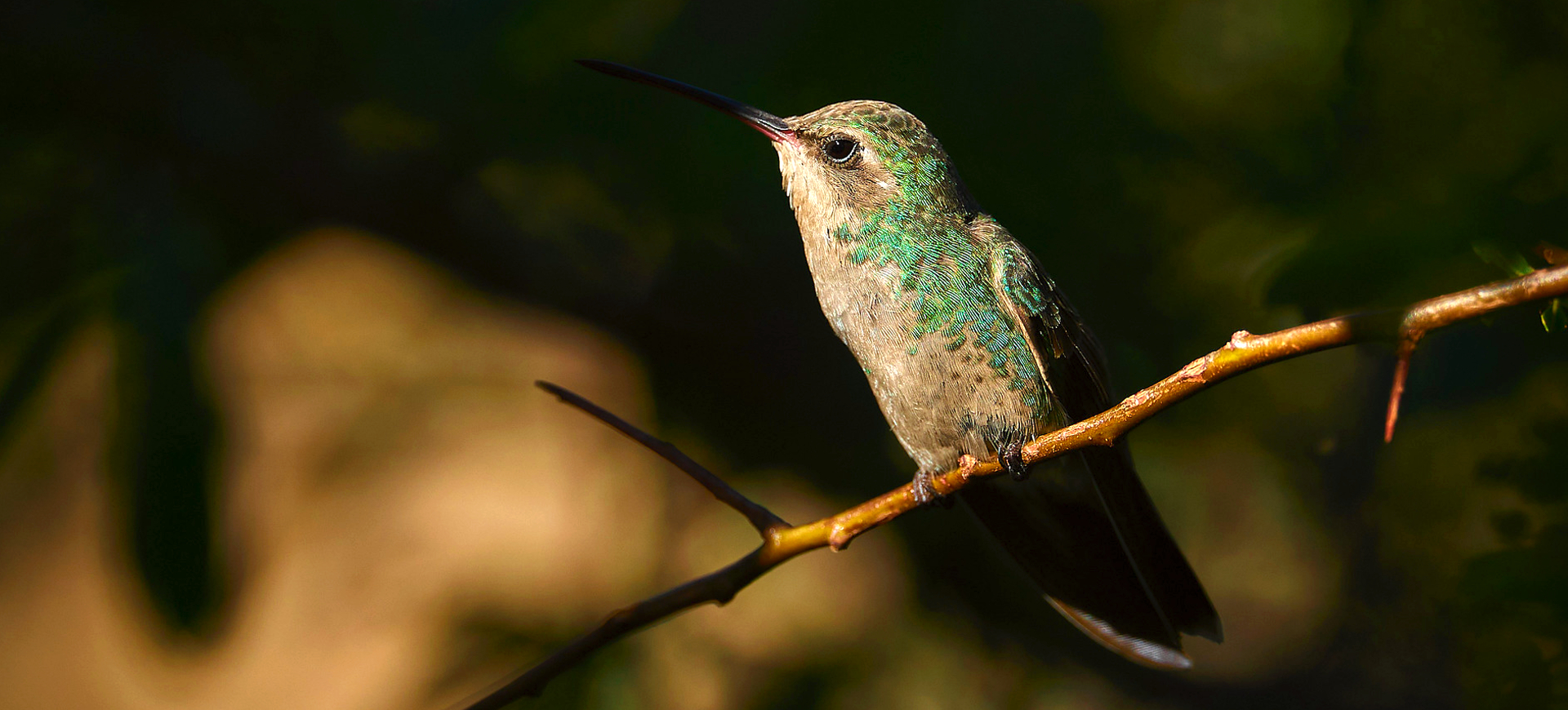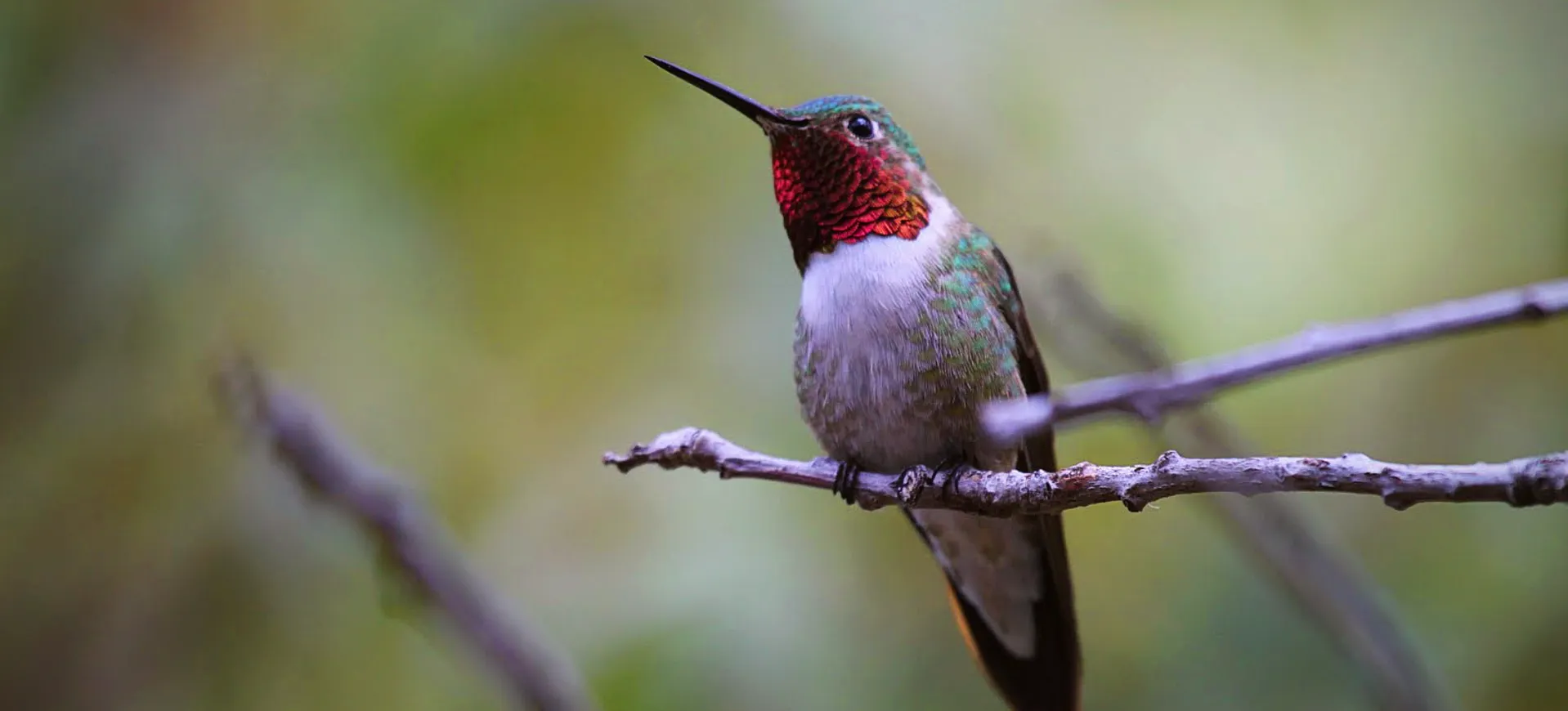Overview
Anna’s Hummingbird (Calypte anna) is a medium-sized hummingbird native to the western coastal regions of North America. Renowned for its remarkable adaptability, this species has expanded its range significantly over the past century, now spanning from British Columbia in Canada down through Baja California in Mexico. Anna’s Hummingbirds are particularly noted for their vibrant plumage; males display a brilliant iridescent emerald green back and a vivid rose-pink throat, while females are more subdued, with green upperparts and grayish underparts, often showing spots of the male’s throat color.
Unlike many hummingbird species that migrate long distances, Anna’s Hummingbirds are largely resident throughout their range, taking advantage of the relatively mild winter climates and the abundance of flowering plants in urban and suburban gardens. They are early breeders, with their breeding season beginning in late winter, a strategy that allows them to take advantage of the winter-flowering plants in their habitat. Anna’s Hummingbirds play a critical role in pollination, feeding on nectar from various flowers and, in turn, transferring pollen.
Their flight abilities are extraordinary. They can hover in place with rapid wing beats and perform spectacular aerial displays. Males are known for their dramatic courtship dives, plummeting from great heights at high speeds to produce a resonant sound with their tail feathers to impress potential mates. This species’ adaptability to human-modified landscapes and year-round presence make it a beloved fixture in many gardens along the Pacific Coast.
Taxonomy
Kingdom
Phylum
Class
Order
Family
Genus
Species
Type
Current distribution:
Today, Anna's Hummingbirds are resident birds across a broad area, from the southwestern coasts of Canada through various states in the U.S., including California, and reaching into parts of Arizona and Mexico. This residency throughout the year is exceptional among North American hummingbirds and is made possible by the consistent availability of food sources in their habitats. These include natural sources and those provided by humans, such as sugar water from feeders in residential gardens. The birds' presence in these areas throughout the year is a testament to their ability to adapt to and benefit from natural and human-provided resources.
Anna's Hummingbirds' year-round residency across their range is a unique aspect of their behavior that sets them apart from many other migratory hummingbird species. The widespread availability of artificial feeders and flowering plants in residential and urban areas facilitates their ability to remain in one area throughout the seasons. This stability in their living conditions supports their populations. It allows them to be a common and beloved fixture in many gardens and natural areas along the Pacific Coast, enriching the biodiversity of these environments.
Physical Description:
Anna’s Hummingbird measures about 3.9 to 4.3 inches in length, making it one of the largest hummingbird species found in North America. Males can be easily identified by their glossy green feathers and striking, iridescent rose-pink throat and head, which can appear almost fluorescent in direct sunlight. Females, while less colorful, possess a subtle beauty with their green backs, white underparts with some green spotting, and a delicate pinkish hue on their throats.
Their long and narrow wings enable the rapid, precise movements necessary for their hovering feeding strategy. Anna’s Hummingbirds have a straight, slender bill adapted for extracting nectar from flowers, a key aspect of their diet. The tail of the male is slightly forked, while the female’s tail is rounded with white tips on the outer feathers, differences that can aid in identification.

Lifespan: Wild: ~7 Years || Captivity: ~9 Years

Weight: Male & Female: 0.1-0.2 oz (3-6 g)

Length: Male & Female: 3.9-4.3 in (10-11 cm)

Wingspan: Male & Female: 4-5 in (12-15 cm)

Top Speed: 45 mph (72 km/h)
Characteristic:
Native Habitat:
Anna’s Hummingbirds, originally from the coastal and chaparral regions of California and Baja California, have significantly extended their range into the Pacific Northwest. This expansion includes areas such as Washington, Oregon, and southwestern British Columbia, largely due to human influences like the proliferation of artificial feeding stations and the planting of exotic flowering plants. These birds have shown a remarkable capacity to adapt to various environments, not limited to their native habitats but extending into open woodlands, scrublands, and even human-dominated landscapes like urban and suburban gardens. Their adaptability demonstrates their ability to thrive in various conditions significantly altered by human activity.
The range expansion of Anna’s Hummingbirds into the Pacific Northwest highlights their adaptability to both natural and urbanized environments. By utilizing resources such as artificial feeders and exotic garden plants, these birds have managed to maintain a year-round presence far beyond their original habitat. This adaptability has allowed them to become a common sight in many urban and suburban areas, where they contribute to pollinating various plant species, underscoring the interconnectedness of Anna’s Hummingbirds with human-altered ecosystems.
Climate Zones:
Biomes:
Biogeographical Realms:
Continents:
Countries:
Diet:
Diet & Feeding Habits:
Anna’s Hummingbirds are primarily nectarivores, feeding on the nectar from a wide array of flowers. They favor tubular flowers for their high nectar output but are not exclusive and will feed from various flowering plants. This diet is supplemented by small insects and spiders, providing essential proteins and fats. They are known to visit feeders, where they consume sugar-water mixtures that mimic the nutritional value of natural nectar.
Their feeding strategy involves hovering and darting from flower to flower, demonstrating remarkable agility in the air. Anna’s Hummingbirds play a significant role in their ecosystems as pollinators, facilitating the reproduction of many flowering plant species. The presence of Anna’s Hummingbirds in gardens and natural habitats underscores the importance of maintaining floral diversity to support pollinator populations.
Mating Behavior:
Mating Description:
The courtship of Anna’s Hummingbirds is notable for the male’s spectacular aerial display. To attract a female, the male ascends 130 feet into the air, then dives at high speeds toward the ground, pulling up at the last moment to create a loud, distinctive popping sound with its tail feathers. This display, combined with the visual spectacle of his iridescent plumage in the sunlight, is intended to impress potential mates.
Females are solely responsible for nest construction and raising the young. They build a small, cup-shaped nest using plant down and spider silk, which allows the nest to expand as the chicks grow. The female lays two white eggs, which she incubates for about two weeks. After hatching, the chicks are fed a regurgitated nectar and insects diet until they are ready to fledge, about 18-23 days later.
Reproduction Season:
Birth Type:
Pregnancy Duration:
Female Name:
Male Name:
Baby Name:
Social Structure Description:
Outside the breeding season, Anna’s Hummingbirds lead solitary lives, with males establishing and fiercely defending territories rich in food resources. This territorial behavior is crucial for attracting females during the breeding season, demonstrating the importance of these areas for their reproductive success. The males’ aggressive defense of their territories and their spectacular courtship displays, including high-speed dives and vocalizations, are key aspects of their social interactions. These behaviors reflect the complex social dynamics of Anna’s Hummingbirds, centered around competition for resources and mating opportunities.
During the breeding season, the intricate social structure of Anna’s Hummingbirds becomes even more apparent. Males use dramatic courtship displays to attract females, showcasing their vibrant plumage and aerial agility. The establishment of territories not only serves as a means to secure mating opportunities but also plays a vital role in the survival of the species by ensuring access to necessary food sources. This solitary and territorial nature underscores Anna’s Hummingbirds’ complex behaviors and survival strategies, highlighting their adaptability and resilience in environmental challenges.
Groups:
Conservation Status:
Population Trend:
Anna’s Hummingbirds, classified as Least Concern by the IUCN, exhibit a stable population trend across their extensive range. Their adaptability to natural and human-altered environments has played a significant role in maintaining healthy populations. The widespread availability of artificial feeders and the planting of flowering plants in urban and suburban areas have provided reliable food sources, supporting their residency and breeding success year-round. Despite this, the species’ reliance on specific habitats and food sources makes them sensitive to environmental changes and human activities, emphasizing the need for ongoing monitoring and conservation efforts to ensure their populations remain robust.
Efforts to preserve Anna’s Hummingbirds’ habitats and food sources are crucial for their continued success. As they navigate the challenges of urban expansion, climate change, and pesticide use, the conservation and research community remains vigilant in identifying and mitigating potential threats. Public education and community involvement in conservation practices play a key role in safeguarding these vibrant birds. By maintaining the biodiversity of urban, suburban, and natural landscapes, we can help ensure that Anna’s Hummingbirds continue to thrive, enriching our environments with their presence and contributing to the pollination of plants.
Population Threats:
The main threats to Anna’s Hummingbirds include habitat loss due to urban development, which reduces their natural living spaces, and climate change, which impacts the seasonal availability of the flowering plants they depend on for nectar. The use of pesticides in residential and agricultural areas also poses a significant risk, diminishing the insect populations that form a crucial part of their diet. Furthermore, urban hazards such as window collisions and predation by domestic pets add to the mortality rates of these birds, highlighting the various challenges they face in environments shared with humans.
Despite their adaptability, Anna’s Hummingbirds are not immune to the pressures exerted by human activities and environmental changes. The alteration of their natural habitats through urban expansion, the effects of climate change on plant phenology, and the dangers posed by urban living conditions, such as window strikes and pet predation, represent significant threats to their populations. These factors underscore the importance of conscious efforts to mitigate impacts and support the conservation of Anna’s Hummingbirds and their ecosystems.
Conservation Efforts:
Conservation initiatives aimed at supporting Anna’s Hummingbirds focus on preserving and enhancing their habitats through the planting of native flowering plants and the reduction of pesticide use. Conservationists hope to create sustainable environments for these birds in both rural and urban settings by promoting the growth of plant species that provide natural nectar sources. Public education plays a crucial role in these efforts, raising awareness about the importance of conservation practices that benefit Anna’s Hummingbirds and other pollinators. Establishing bird sanctuaries and maintaining green spaces within urban environments are additional strategies that provide safe havens for these birds, contributing to their conservation and the overall biodiversity of the areas they inhabit.
Efforts to conserve Anna’s Hummingbirds also include initiatives to create bird-friendly environments in urban and suburban landscapes. Encouraging the community to participate in bird conservation through the planting of native species and the reduction of pesticide use helps to ensure the availability of essential resources for these hummingbirds. Moreover, creating sanctuaries and preserving green spaces offer refuge from the hazards of urban development, playing a critical role in the survival and well-being of Anna’s Hummingbirds. These conservation measures support the species and enhance the ecological health of their habitats, benefiting a wide range of flora and fauna.
Additional Resources:
Fun Facts
- Anna’s Hummingbirds are named after Anna Masséna, Duchess of Rivoli.
- They can beat their wings up to 70 times per second during normal flight and even faster during courtship dives.
- Anna’s Hummingbirds are among the few birds capable of producing vocal sounds during flight using their tail feathers.
- They have excellent memory, which helps them remember the location of every flower they feed from and how long it will take each flower to replenish.
- Anna’s Hummingbirds can adjust the angle of their body and tail to change the color of their luminosity, using this ability to communicate during courtship displays.
- Unlike most birds, hummingbirds can rotate their wings full circle, enabling them to hover and fly backward.
- They can enter a state of torpor at night or when food is scarce, significantly reducing their metabolic rate to conserve energy.
- Anna’s Hummingbirds are among the few North American hummingbirds expanding their range, partly due to the planting of exotic flowers and the availability of artificial feeders.


